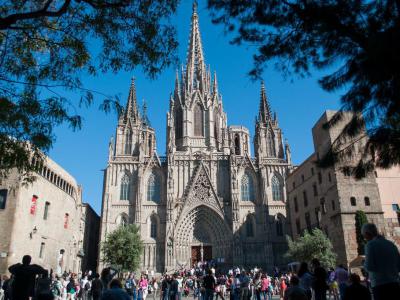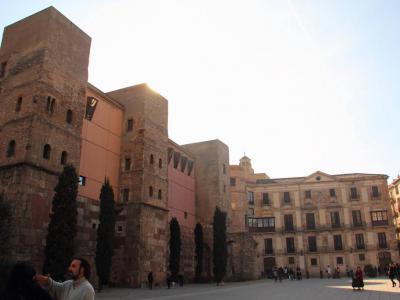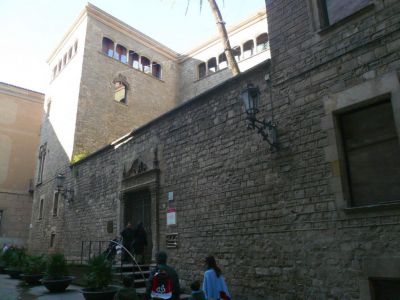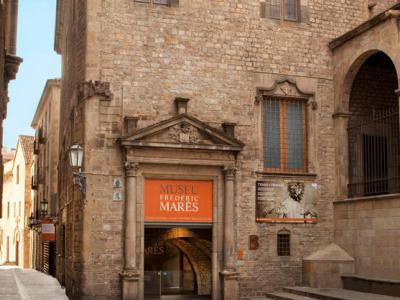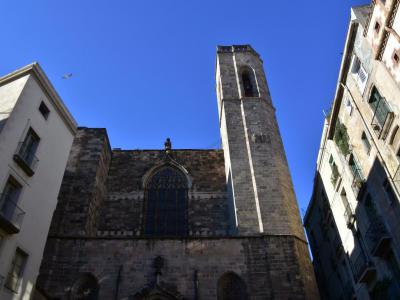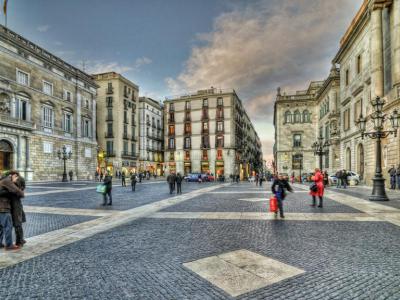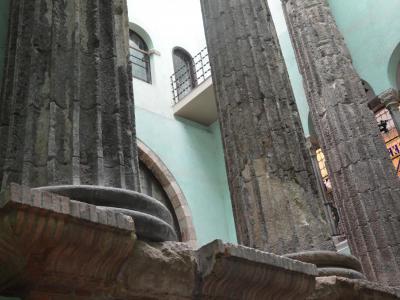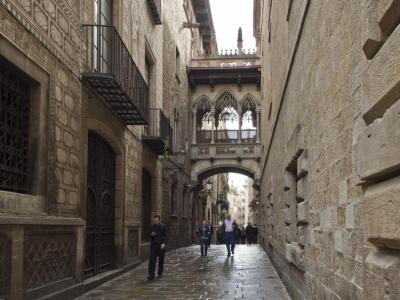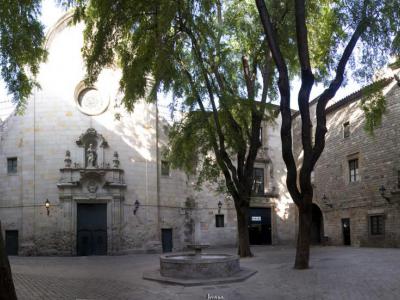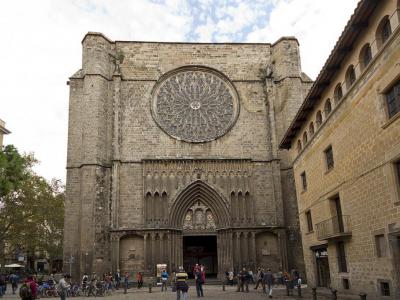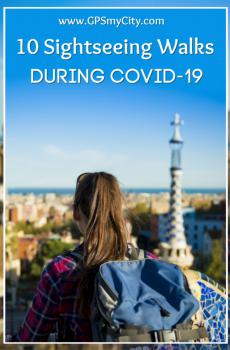
Gothic Quarter Walking Tour (Self Guided), Barcelona
A walk through the Gothic Quarter – Barcelona’s oldest part, dating from the Roman era – is like a journey through time. The typical Roman grid plan is still visible in the quarter's layout. Only a few roads are open for car traffic, so there is little in the way of enjoying the narrow, atmospheric streets filled with high-quality architecture, numerous boutiques, and coffee shops. Melding medieval charm with the vibrancy of modern life, this labyrinthine district is home to a multitude of landmarks.
At the core of the Gothic Quarter stands the imposing Barcelona Cathedral, a beacon of Gothic architecture adorned with intricate spires that pierce the skyline. Nearby, the Archdeacon's House mesmerizes visitors with its tranquil courtyard and historical archives. A short stroll away, New Square serves as a gateway to the area's ancient roots, framed by the remnants of old Roman walls.
The Frederic Mares Museum, housed in the Lieutenant’s Palace, offers a deep dive into Spanish sculpture and decorative arts, showcasing collections that span centuries. King's Square, further ahead, is a historic ensemble that hosts the Grand Royal Palace, revealing layers of the city's Roman and medieval past.
The Royal Chapel of Saint Agatha and the adjacent Saint Justus Square offer serene spots, steeped in the spiritual heritage of Barcelona. The bustling Saint James's Square contrasts sharply, lined with prominent buildings like the Palace of the Generalitat, housing Catalonia's government.
Not to be missed is the Temple of Augustus, where ancient Roman columns majestically complement the medieval setting. The enchanting Bishop's Bridge connects historic edifices with Gothic allure, while Saint Philip Neri Square offers a quiet refuge, shadowed by its tragic past and beautiful baroque church.
For those drawn to religious architecture, the Basilica of Saint Mary of the Pine showcases impressive Gothic masonry. At the same time, the inviting Saint Joseph Oriol Square comes alive with multiple artists and musicians.
The Gothic Quarter is more than just a district but the heartbeat of Barcelona, where every corner tells a story. This is one of those medieval urban landscapes where you can easily get lost. Follow our self-guided walk to appreciate the area's main landmarks and let it captivate your imagination – a nice way to “lose yourself” while staying on the right course.
At the core of the Gothic Quarter stands the imposing Barcelona Cathedral, a beacon of Gothic architecture adorned with intricate spires that pierce the skyline. Nearby, the Archdeacon's House mesmerizes visitors with its tranquil courtyard and historical archives. A short stroll away, New Square serves as a gateway to the area's ancient roots, framed by the remnants of old Roman walls.
The Frederic Mares Museum, housed in the Lieutenant’s Palace, offers a deep dive into Spanish sculpture and decorative arts, showcasing collections that span centuries. King's Square, further ahead, is a historic ensemble that hosts the Grand Royal Palace, revealing layers of the city's Roman and medieval past.
The Royal Chapel of Saint Agatha and the adjacent Saint Justus Square offer serene spots, steeped in the spiritual heritage of Barcelona. The bustling Saint James's Square contrasts sharply, lined with prominent buildings like the Palace of the Generalitat, housing Catalonia's government.
Not to be missed is the Temple of Augustus, where ancient Roman columns majestically complement the medieval setting. The enchanting Bishop's Bridge connects historic edifices with Gothic allure, while Saint Philip Neri Square offers a quiet refuge, shadowed by its tragic past and beautiful baroque church.
For those drawn to religious architecture, the Basilica of Saint Mary of the Pine showcases impressive Gothic masonry. At the same time, the inviting Saint Joseph Oriol Square comes alive with multiple artists and musicians.
The Gothic Quarter is more than just a district but the heartbeat of Barcelona, where every corner tells a story. This is one of those medieval urban landscapes where you can easily get lost. Follow our self-guided walk to appreciate the area's main landmarks and let it captivate your imagination – a nice way to “lose yourself” while staying on the right course.
How it works: Download the app "GPSmyCity: Walks in 1K+ Cities" from Apple App Store or Google Play Store to your mobile phone or tablet. The app turns your mobile device into a personal tour guide and its built-in GPS navigation functions guide you from one tour stop to next. The app works offline, so no data plan is needed when traveling abroad.
Gothic Quarter Walking Tour Map
Guide Name: Gothic Quarter Walking Tour
Guide Location: Spain » Barcelona (See other walking tours in Barcelona)
Guide Type: Self-guided Walking Tour (Sightseeing)
# of Attractions: 15
Tour Duration: 2 Hour(s)
Travel Distance: 1.8 Km or 1.1 Miles
Author: clare
Sight(s) Featured in This Guide:
Guide Location: Spain » Barcelona (See other walking tours in Barcelona)
Guide Type: Self-guided Walking Tour (Sightseeing)
# of Attractions: 15
Tour Duration: 2 Hour(s)
Travel Distance: 1.8 Km or 1.1 Miles
Author: clare
Sight(s) Featured in This Guide:
- Catedral de Barcelona (Barcelona Cathedral)
- Placa Nova (New Square)
- Casa de l'Ardiaca (Archdeacon's House)
- Museu Frederic Mares (Frederic Mares Museum)
- Palau del Lloctinent (Lieutenant’s Palace)
- Placa del Rei (King's Square)
- Capella Reial de Santa Agata (Royal Chapel of St. Agatha)
- Placa Sant Just (St. Justus Square)
- Placa de Sant Jaume (St. James's Square)
- Temple d'August - MUHBA (Temple of Augustus)
- Pont del Bisbe (Bishop's Bridge)
- Palau de la Generalitat (Palace of the Generalitat)
- Placa de Sant Felip Neri (St. Philip Neri Square)
- Basilica de Santa Maria del Pi (Basilica of St. Mary of the Pine)
- Placa de Sant Josep Oriol (St. Joseph Oriol Square)
1) Catedral de Barcelona (Barcelona Cathedral) (must see)
The Cathedral of the Holy Cross and Saint Eulalia, commonly known as Barcelona Cathedral, is a delightful combination of a church, mini-park, and a house of prayer, offering a serene alternative to the renowned La Sagrada Família. As the seat of the Archbishop of Barcelona, it was primarily constructed between the 13th and 15th centuries.
The cathedral has a pseudo-basilica layout with five aisles and a raised high altar. It is dedicated to Saint Eulalia, a young martyr whose relics are housed in the white marble sarcophagus inside the crypt. An intriguing feature is the presence of 13 geese in the cloister, symbolizing Saint Eulàlia's age at the time of her death.
Inside, the cathedral showcases choir stalls adorned with the coats-of-arms of the Order of the Golden Fleece. The Chapel of the Holy Sacrament contains a cross associated with the 1571 Battle of Lepanto and has been reconstructed to hold the tomb of San Olegarius, a former bishop of Barcelona.
The cathedral’s origins trace back to an early Christian and Visigothic complex that was damaged during a Muslim attack on Barcelona in 985. It was replaced with a Romanesque church in 1046 before the current Gothic cathedral began construction in 1298. The cathedral took 150 years to complete yet its neo-Gothic façade, featuring gargoyles and other mythical creatures, was finished only in 1913. Unlike many other churches in Barcelona destroyed during the Civil War, this Gothic temple was spared.
An exemplary piece of Catalan Gothic architecture, emphasizing balanced proportions over verticality, the cathedral measures 93 meters long, 40 meters wide, and 28 meters high at its central nave, with bell towers reaching 54 meters and the central peak at 70 meters.
The Cathedral of Barcelona is also famous for giving rise to the unique Catalan tradition of "dancing egg." Observed during the feast of Corpus Christi (also known as the Solemnity of the Most Holy Body and Blood of Christ), this tradition features an egg balanced on a water fountain’s jet.
The cathedral's cloister contains a gift shop. Cellular phones have been banned from the Chapel of Lepanto and other chapels. While exploring the cathedral's interior, make sure to venture up to the lofty roof terrace. You will be rewarded with views of the cathedral's towers, pinnacles, cimborio, and the Cloister, and a 360-degree view of the city!
Tip:
Cathedral Visit (including Choir entrance + Access to the rooftop, Chapter hall, and Virtual Audio guide) is €9.00.
Cathedral + Museum (including Choir entrance + Access to the rooftop + Chapter hall + Virtual Audio guide + Museum) is €15.00.
The cathedral has a pseudo-basilica layout with five aisles and a raised high altar. It is dedicated to Saint Eulalia, a young martyr whose relics are housed in the white marble sarcophagus inside the crypt. An intriguing feature is the presence of 13 geese in the cloister, symbolizing Saint Eulàlia's age at the time of her death.
Inside, the cathedral showcases choir stalls adorned with the coats-of-arms of the Order of the Golden Fleece. The Chapel of the Holy Sacrament contains a cross associated with the 1571 Battle of Lepanto and has been reconstructed to hold the tomb of San Olegarius, a former bishop of Barcelona.
The cathedral’s origins trace back to an early Christian and Visigothic complex that was damaged during a Muslim attack on Barcelona in 985. It was replaced with a Romanesque church in 1046 before the current Gothic cathedral began construction in 1298. The cathedral took 150 years to complete yet its neo-Gothic façade, featuring gargoyles and other mythical creatures, was finished only in 1913. Unlike many other churches in Barcelona destroyed during the Civil War, this Gothic temple was spared.
An exemplary piece of Catalan Gothic architecture, emphasizing balanced proportions over verticality, the cathedral measures 93 meters long, 40 meters wide, and 28 meters high at its central nave, with bell towers reaching 54 meters and the central peak at 70 meters.
The Cathedral of Barcelona is also famous for giving rise to the unique Catalan tradition of "dancing egg." Observed during the feast of Corpus Christi (also known as the Solemnity of the Most Holy Body and Blood of Christ), this tradition features an egg balanced on a water fountain’s jet.
The cathedral's cloister contains a gift shop. Cellular phones have been banned from the Chapel of Lepanto and other chapels. While exploring the cathedral's interior, make sure to venture up to the lofty roof terrace. You will be rewarded with views of the cathedral's towers, pinnacles, cimborio, and the Cloister, and a 360-degree view of the city!
Tip:
Cathedral Visit (including Choir entrance + Access to the rooftop, Chapter hall, and Virtual Audio guide) is €9.00.
Cathedral + Museum (including Choir entrance + Access to the rooftop + Chapter hall + Virtual Audio guide + Museum) is €15.00.
2) Placa Nova (New Square)
Despite its name, New Square is the oldest square in Barcelona, founded in 1358. Until the 14th century, the area remained undeveloped, serving as a hay market behind the gates of the Roman settlement of Barcino.
New Square was built following a municipal council decision in 1355 to channel water from the Collserola mountains to the Square of Saint James. Throughout its history, the square has mostly kept its original name, except for a brief period, in the early 20th century, when it was renamed after Carlist Juan Vázquez de Mella.
The square has an irregular, triangular shape and, in the past century, was the site of several archaeological excavations. In 1994, the sculptural poem "Barcino" was installed, adding a modern touch to the area.
Several historical buildings surrounding the square include the medieval Baroque-style Bishop’s Palace and the Architects' Association of Catalonia building, featuring sand-cast friezes by Pablo Picasso. Other highlights are the remnants of the Roman wall and the gateway that once led to the ancient Forum, dating back to the 1st century BC and 4th century AD respectively. Two circular towers flanking the gate were added in the 12th century. Additionally, near the Archdeacon’s House, one can view fragments of the Roman aqueduct.
Tip:
Each Thursday, from 9 am to 8 pm, New Square hosts an antiques market.
New Square is also a venue for dance festivals – Sardanas, – particularly on the day of Saint Roch, a Majorcan Catholic confessor whose death is commemorated on 16 August.
New Square was built following a municipal council decision in 1355 to channel water from the Collserola mountains to the Square of Saint James. Throughout its history, the square has mostly kept its original name, except for a brief period, in the early 20th century, when it was renamed after Carlist Juan Vázquez de Mella.
The square has an irregular, triangular shape and, in the past century, was the site of several archaeological excavations. In 1994, the sculptural poem "Barcino" was installed, adding a modern touch to the area.
Several historical buildings surrounding the square include the medieval Baroque-style Bishop’s Palace and the Architects' Association of Catalonia building, featuring sand-cast friezes by Pablo Picasso. Other highlights are the remnants of the Roman wall and the gateway that once led to the ancient Forum, dating back to the 1st century BC and 4th century AD respectively. Two circular towers flanking the gate were added in the 12th century. Additionally, near the Archdeacon’s House, one can view fragments of the Roman aqueduct.
Tip:
Each Thursday, from 9 am to 8 pm, New Square hosts an antiques market.
New Square is also a venue for dance festivals – Sardanas, – particularly on the day of Saint Roch, a Majorcan Catholic confessor whose death is commemorated on 16 August.
3) Casa de l'Ardiaca (Archdeacon's House)
The Archdeacon's House is a former 12th-century Romanesque structure converted between 1479 and 1514 into a palace. Notable for its "Roman style" portal, the building merges medieval Gothic architecture with Renaissance elements. Over the years, significant modifications have included a new facade and a courtyard added in the 16th century, driven by various ecclesiastical residents seeking to expand or beautify their abode.
In 1895, the house accommodated the headquarters of the Bar Association of Barcelona, which commissioned prominent Catalan architect Lluís Domènech to renovate it. In the early 20th century, the property endured structural damages and ownership transitions until it was sold to the Barcelona City Council. Following this, significant restoration and adaptation work was carried out to house the Historical Archive of Barcelona, culminating in the building's declaration as a historical-artistic monument in 1924.
In the mid-20th century, the structure saw further modifications focused on enhancing the visibility of the adjacent Romanesque chapel of Santa Eulàlia and integrating Roman architectural remnants, such as the Roman wall on the ground floor and part of the Collserola aqueduct. A closer look at the Montjuïc sandstone making up the building reveals intricately carved and beveled blocks from other structures. This is a testament to the Romans' hurried fortification of the site in the face of the onslaught from the north by the Visigoths which marked the end of the 200-year-long period of Roman hegemony in the region.
Despite its location in one of the busiest tourist areas of Barcelona, entry to the building is free. The inner courtyard exudes a surprising tranquility, making it one of the most evocative spaces in the city. The courtyard showcases exquisite tile work, and at its center, you can see a tall, graceful palm tree towering above a flower-adorned fountain. This fountain holds a curious tradition: on Corpus Christi Day in June, it hosts an impressive spectacle known as "the dancing egg," featuring eggs bobbing atop jets of water.
Tip:
At the front entrance of the House, look out for what may well be the most attractive letterbox you've ever seen! Crafted from marble and created in 1895 by Lluís Domènech for the Bar Association of Barcelona, it holds a symbolic meaning. Doves represent the lofty flight towards justice, while turtles symbolize the slow pace of administrative procedures.
In 1895, the house accommodated the headquarters of the Bar Association of Barcelona, which commissioned prominent Catalan architect Lluís Domènech to renovate it. In the early 20th century, the property endured structural damages and ownership transitions until it was sold to the Barcelona City Council. Following this, significant restoration and adaptation work was carried out to house the Historical Archive of Barcelona, culminating in the building's declaration as a historical-artistic monument in 1924.
In the mid-20th century, the structure saw further modifications focused on enhancing the visibility of the adjacent Romanesque chapel of Santa Eulàlia and integrating Roman architectural remnants, such as the Roman wall on the ground floor and part of the Collserola aqueduct. A closer look at the Montjuïc sandstone making up the building reveals intricately carved and beveled blocks from other structures. This is a testament to the Romans' hurried fortification of the site in the face of the onslaught from the north by the Visigoths which marked the end of the 200-year-long period of Roman hegemony in the region.
Despite its location in one of the busiest tourist areas of Barcelona, entry to the building is free. The inner courtyard exudes a surprising tranquility, making it one of the most evocative spaces in the city. The courtyard showcases exquisite tile work, and at its center, you can see a tall, graceful palm tree towering above a flower-adorned fountain. This fountain holds a curious tradition: on Corpus Christi Day in June, it hosts an impressive spectacle known as "the dancing egg," featuring eggs bobbing atop jets of water.
Tip:
At the front entrance of the House, look out for what may well be the most attractive letterbox you've ever seen! Crafted from marble and created in 1895 by Lluís Domènech for the Bar Association of Barcelona, it holds a symbolic meaning. Doves represent the lofty flight towards justice, while turtles symbolize the slow pace of administrative procedures.
4) Museu Frederic Mares (Frederic Mares Museum)
The Frederic Marès Museum is a treasure trove of art and history housed within the former Royal Palace of the Counts of Barcelona. Established in 1948, the museum has grown from a modest exhibition of Frederic Marès's own collection into a profound cultural landmark.
Frederic Marès, a distinguished 20th-century sculptor and collector, initially displayed his works here in 1944, which ultimately led to the museum's creation. By 1970, the collection expanded extensively, fueled by acquisitions and donations.
Marès's influence is evident in the thematic organization of the museum, which comprises seven sections, each dedicated to a specific historical period. The displayed items – monumental stonework, religious polychrome carvings, and commemorative medals – showcase a transition from the ancient Mediterranean to Gothic, Renaissance, and Baroque styles, culminating in a rich display of 19th-century Hispanic neoclassical art and Catalan Modernism. Among the most notable exhibits are the Romanesque "Apparition of Jesus to his Disciples at the Sea" and the 12th-century "Mother of God with the Child".
Besides sculptures, the museum offers a "collector's cabinet," an eclectic compilation of 19th-century artifacts that provide a window into the daily lives of that era, from jewelry and clocks to old photographs and documents. This section, along with the museum’s study library, preserves the intimate atmosphere of Marès's original studio, offering visitors a personal glimpse into the collector’s ethos.
For those interested in a deeper exploration, the museum offers audio guides, enhancing the visitor experience with rich narratives and historical context – a peaceful afternoon of cultural immersion guaranteed.
Tip:
For a delightful escape during the summer, discover the secluded onsite tree-filled café. It may be slightly hidden (follow the steps leading down into the courtyard) but offers a warm and friendly atmosphere, along with delicious food and drinks.
Frederic Marès, a distinguished 20th-century sculptor and collector, initially displayed his works here in 1944, which ultimately led to the museum's creation. By 1970, the collection expanded extensively, fueled by acquisitions and donations.
Marès's influence is evident in the thematic organization of the museum, which comprises seven sections, each dedicated to a specific historical period. The displayed items – monumental stonework, religious polychrome carvings, and commemorative medals – showcase a transition from the ancient Mediterranean to Gothic, Renaissance, and Baroque styles, culminating in a rich display of 19th-century Hispanic neoclassical art and Catalan Modernism. Among the most notable exhibits are the Romanesque "Apparition of Jesus to his Disciples at the Sea" and the 12th-century "Mother of God with the Child".
Besides sculptures, the museum offers a "collector's cabinet," an eclectic compilation of 19th-century artifacts that provide a window into the daily lives of that era, from jewelry and clocks to old photographs and documents. This section, along with the museum’s study library, preserves the intimate atmosphere of Marès's original studio, offering visitors a personal glimpse into the collector’s ethos.
For those interested in a deeper exploration, the museum offers audio guides, enhancing the visitor experience with rich narratives and historical context – a peaceful afternoon of cultural immersion guaranteed.
Tip:
For a delightful escape during the summer, discover the secluded onsite tree-filled café. It may be slightly hidden (follow the steps leading down into the courtyard) but offers a warm and friendly atmosphere, along with delicious food and drinks.
5) Palau del Lloctinent (Lieutenant’s Palace)
Just past the Frederic Marès Museum, a handsome doorway beckons you into the refined courtyard of the Lieutenant’s Palace, adorned with its three facades. As part of the former royal palace, the Lieutenant’s Palace boasts a typical mix of late Gothic and early Renaissance Catalan design. One of the most elegant buildings in the Gothic Quarter, it was constructed between 1549 and 1557 by master builder Antoni Carbonell, commissioned by the Government of Catalonia (known as the Generalitat).
During the 16th and 17th centuries, the Palace served as the residence of the king's official emissary (or viceroy) in Barcelona. From 1836 until 1994, the graceful structure served as the headquarters for the General Archive of the Crown of Aragon and today offers an excellent exhibition on the life and era of James I the Conqueror, King of Aragon, one of Catalonia's prominent historic figures from the 13th century.
The building features a rectangular plan with four floors and basements, centering around a large courtyard. The ground floor includes four large carpanel arches on pillars, supporting a Tuscan-type gallery with semicircular arches, and an Italian palace-style staircase leading to the upper floors. The weighty stone arches adorning the entrance, the central patio, and the intricately adorned wooden roof above the staircase all exemplify the noble architecture of the 16th century. The door on the stairway, dating to 1975, showcases scenes from the life of Saint George and the history of Catalonia.
The courtyard also occasionally hosts concerts featuring early music. Additionally, during the Corpus Christi celebration, it becomes one of the main venues for the "dancing egg" spectacle, featuring an egg "dancing" on the fountain jet amidst an elaborate floral arrangement.
During the 16th and 17th centuries, the Palace served as the residence of the king's official emissary (or viceroy) in Barcelona. From 1836 until 1994, the graceful structure served as the headquarters for the General Archive of the Crown of Aragon and today offers an excellent exhibition on the life and era of James I the Conqueror, King of Aragon, one of Catalonia's prominent historic figures from the 13th century.
The building features a rectangular plan with four floors and basements, centering around a large courtyard. The ground floor includes four large carpanel arches on pillars, supporting a Tuscan-type gallery with semicircular arches, and an Italian palace-style staircase leading to the upper floors. The weighty stone arches adorning the entrance, the central patio, and the intricately adorned wooden roof above the staircase all exemplify the noble architecture of the 16th century. The door on the stairway, dating to 1975, showcases scenes from the life of Saint George and the history of Catalonia.
The courtyard also occasionally hosts concerts featuring early music. Additionally, during the Corpus Christi celebration, it becomes one of the main venues for the "dancing egg" spectacle, featuring an egg "dancing" on the fountain jet amidst an elaborate floral arrangement.
6) Placa del Rei (King's Square)
King's Square epitomizes Barcelona's historical essence as the center of county and royal authority. Originating from an urbanization initiative by King Martí I of Aragon, otherwise known as Martí the Human, in the late 14th century, the square was designed to host tournaments, displacing the traditional market. It retains a rectangular shape and is encased by Gothic and Renaissance buildings, creating a closed circuit except for its southwest end.
The square's name comes from the Grand Royal Palace of the Counts of Barcelona whose Gothic facade dominates its north side. The palace complex also encompasses the exquisite 13th-century Royal Chapel of Santa Agata and the romantic Renaissance Tower of King Martí, which offers views over the medieval city. The eastern edge is marked by the 14th-century Tinell Hall, the palace's central hall, accessible via a staircase.
According to historians, it was on these very steps, which spread out from the corner of the square, that in 1493 King Ferdinand and Queen Isabella welcomed Christopher Columbus and his crew upon their return from the first successful voyage to the New World. Once used as a meeting place for the Spanish Inquisition, the hall capitalized on the popular belief that its walls would reveal any lies spoken within. Nowadays, the building hosts temporary exhibitions and occasional concerts.
This square's main royal edifices can be accessed through the Barcelona History Museum, housed in the impressive Gothic Padellàs building. Together with the 16th-century Renaissance Lieutenant’s Palace, they complete the square's layout.
Additionally, King's Square's underground shelters extensive Roman ruins, uncovered in 1935. Ten years later, during renovations on the neighboring Counts Street, another archaeological discovery was made – an early Christian basilica, initially thought to be a primitive cathedral. In 1954, they also unearthed a 1st-century Roman pavement and nymphaeum (a shrine to the nymphs), providing insights into the area's historical development.
Due to its tremendous acoustic and almost enclosed structure, the square often serves as a venue for musical concerts and public events.
Tip:
The Barcelona History Museum, open Tuesday through Saturday from 10 am–7 pm and on Sunday from 10 am–8 pm, offers a fascinating glimpse into Roman and early Christian Barcelona. Visitors can explore ancient Roman ruins on a tour beginning underground and concluding in a lively square, perfect for relaxing with a drink.
The square's name comes from the Grand Royal Palace of the Counts of Barcelona whose Gothic facade dominates its north side. The palace complex also encompasses the exquisite 13th-century Royal Chapel of Santa Agata and the romantic Renaissance Tower of King Martí, which offers views over the medieval city. The eastern edge is marked by the 14th-century Tinell Hall, the palace's central hall, accessible via a staircase.
According to historians, it was on these very steps, which spread out from the corner of the square, that in 1493 King Ferdinand and Queen Isabella welcomed Christopher Columbus and his crew upon their return from the first successful voyage to the New World. Once used as a meeting place for the Spanish Inquisition, the hall capitalized on the popular belief that its walls would reveal any lies spoken within. Nowadays, the building hosts temporary exhibitions and occasional concerts.
This square's main royal edifices can be accessed through the Barcelona History Museum, housed in the impressive Gothic Padellàs building. Together with the 16th-century Renaissance Lieutenant’s Palace, they complete the square's layout.
Additionally, King's Square's underground shelters extensive Roman ruins, uncovered in 1935. Ten years later, during renovations on the neighboring Counts Street, another archaeological discovery was made – an early Christian basilica, initially thought to be a primitive cathedral. In 1954, they also unearthed a 1st-century Roman pavement and nymphaeum (a shrine to the nymphs), providing insights into the area's historical development.
Due to its tremendous acoustic and almost enclosed structure, the square often serves as a venue for musical concerts and public events.
Tip:
The Barcelona History Museum, open Tuesday through Saturday from 10 am–7 pm and on Sunday from 10 am–8 pm, offers a fascinating glimpse into Roman and early Christian Barcelona. Visitors can explore ancient Roman ruins on a tour beginning underground and concluding in a lively square, perfect for relaxing with a drink.
7) Capella Reial de Santa Agata (Royal Chapel of St. Agatha)
Another beautiful Catalan monument in the Gothic Quarter not to be missed, when visiting the Barcelona History Museum, is the Chapel of Saint Agatha. A remarkable example of Catalan Gothic architecture, it was constructed in 1302 under King James II of Aragon and his wife Queen Blanca of Naples as an extension to the Royal Palace, replacing its older oratory. Today, the chapel forms part of the History Museum along with the Tinell Hall.
Significant contributions to the building, such as the addition of the chapel of the Queens and a baptistery, were made in the 14th century during the reigns of King Peter IV of Aragon, popularly known as Peter the Ceremonious, and King Martín I the Humane. Originally dedicated to Santa Maria, its dedication was changed to Santa Àgata in 1601 after the papacy authorized the custody of the saint's relics.
The chapel underwent various uses following the confiscation of ecclesiastical properties in Spain in 1835. Architecturally, it features a single nave with a polygonal apse and a small cross structure, embellished with the coats of arms of Maria of Navarre and Eleonora of Sicily. The nave boasts polychrome wooden roofs with diaphragm arches, while the apse is topped with cross vaults. Stained glass windows with Gothic traceries brighten the interior, and the sacristy is uniquely integrated into the Roman wall.
Adjacent to the sacristy is a 14th-century octagonal bell tower adorned with eight triangular pediments resembling a royal crown. Prominent historical artworks within the chapel include sixty terracotta tiles decorated with images of angels and the coats of arms of Aragon and Sicily.
In 1990, extensive archaeological excavations were conducted in a temple prior to its restoration, uncovering significant historical layers. The work was divided into five areas, revealing structures from the High Imperial period (between 27 BC and 284 AD) through to the 19th century. Key findings included Roman walls, Gothic vaults, and medieval chapels.
Tip:
Admission to the Chapel is included in the Barcelona History Museum entrance fee.
Visitors are permitted to take non-commercial photos inside the chapel, as long as flash photography is avoided. Don't miss the intricately decorated ceiling timbers, the stunning Epiphany altarpiece from 1465, and the Table of Saint Agatha in the Queen's Chapel, dating back to around 1500. Also, keep an eye out for temporary exhibitions in both the chapel and the Tinell Hall, as they offer access to these remarkable buildings without requiring a full museum tour.
Significant contributions to the building, such as the addition of the chapel of the Queens and a baptistery, were made in the 14th century during the reigns of King Peter IV of Aragon, popularly known as Peter the Ceremonious, and King Martín I the Humane. Originally dedicated to Santa Maria, its dedication was changed to Santa Àgata in 1601 after the papacy authorized the custody of the saint's relics.
The chapel underwent various uses following the confiscation of ecclesiastical properties in Spain in 1835. Architecturally, it features a single nave with a polygonal apse and a small cross structure, embellished with the coats of arms of Maria of Navarre and Eleonora of Sicily. The nave boasts polychrome wooden roofs with diaphragm arches, while the apse is topped with cross vaults. Stained glass windows with Gothic traceries brighten the interior, and the sacristy is uniquely integrated into the Roman wall.
Adjacent to the sacristy is a 14th-century octagonal bell tower adorned with eight triangular pediments resembling a royal crown. Prominent historical artworks within the chapel include sixty terracotta tiles decorated with images of angels and the coats of arms of Aragon and Sicily.
In 1990, extensive archaeological excavations were conducted in a temple prior to its restoration, uncovering significant historical layers. The work was divided into five areas, revealing structures from the High Imperial period (between 27 BC and 284 AD) through to the 19th century. Key findings included Roman walls, Gothic vaults, and medieval chapels.
Tip:
Admission to the Chapel is included in the Barcelona History Museum entrance fee.
Visitors are permitted to take non-commercial photos inside the chapel, as long as flash photography is avoided. Don't miss the intricately decorated ceiling timbers, the stunning Epiphany altarpiece from 1465, and the Table of Saint Agatha in the Queen's Chapel, dating back to around 1500. Also, keep an eye out for temporary exhibitions in both the chapel and the Tinell Hall, as they offer access to these remarkable buildings without requiring a full museum tour.
8) Placa Sant Just (St. Justus Square)
At the intersection of Hèrcules Street and Dagueria Street in Barcelona lies a square housing one of the city's oldest Christian churches. The 14th-century Basilica of Saint Justus and Pastor overlooking the square stands on the site of a 4th-century Christian basilica, which was the seat of the archbishop until the Barcelona Cathedral was built. The current basilica is dedicated to the boy martyrs Justus and Pastor, who, as recounted by the Roman poet Prudentius, bravely opposed the persecutions of Christians by the Roman Emperor Diocletian. The boys were captured, whipped, and beheaded near the Spanish city of Alcalá de Henares. Some of the relics associated with these saints have been preserved in a chest that is now housed inside the basilica.
Through the glass openings in the floor inside the basilica, you can see the remains of its 4th-century predecessor. The interior of the basilica is full of mysterious surprises, including several images of the damned burning in hell. Only one tower of the two planned was built to give the church its asymmetrical look. You can climb to the top for the awesome views of the Gothic Quarter.
Underneath the square itself, they say, lie the Christian catacombs.
During the Middle Ages, Saint Justus Square was the only place in town where Jews and Christians were permitted to engage in legal trade together. A reminder of that era is the Gothic fountain, the oldest water source in Barcelona, carved of Montjuïc stone in 1367. Back in the day, various commercial transactions and information exchanges took place here. Between its pipes, you can see three human faces carved in stone beneath a relief of Saint Justus flanked by two shields: one royal and one showing a hawk catching a partridge. These are relatively new additions, dating back to the 19th century.
Through the glass openings in the floor inside the basilica, you can see the remains of its 4th-century predecessor. The interior of the basilica is full of mysterious surprises, including several images of the damned burning in hell. Only one tower of the two planned was built to give the church its asymmetrical look. You can climb to the top for the awesome views of the Gothic Quarter.
Underneath the square itself, they say, lie the Christian catacombs.
During the Middle Ages, Saint Justus Square was the only place in town where Jews and Christians were permitted to engage in legal trade together. A reminder of that era is the Gothic fountain, the oldest water source in Barcelona, carved of Montjuïc stone in 1367. Back in the day, various commercial transactions and information exchanges took place here. Between its pipes, you can see three human faces carved in stone beneath a relief of Saint Justus flanked by two shields: one royal and one showing a hawk catching a partridge. These are relatively new additions, dating back to the 19th century.
9) Placa de Sant Jaume (St. James's Square)
Saint James's Square is the administrative heart of Barcelona, housing both the Government of Catalonia and the Barcelona City Council. It also serves as an excellent landmark for navigating the intricate streets of the Gothic Quarter.
The area's historic roots trace back to the Roman colony of Bàrcino as a crossroads of the main Roman thoroughfares, where the Forum and the Temple of Augustus once stood. Four columns from the Temple have been preserved and can still be seen atop the hill known as Mont Taber.
The square itself has been in existence since at least 1261. A porch where city councilors convened for meetings, the precursor of the future headquarters of the municipal government, was added in the 14th century. In 1598, the Generalitat Palace was enlarged, subsequently extending the square too. Further major transformations occurred in the 19th century when the City Council decided to demolish adjacent buildings to create a larger square, which was inaugurated in 1840 as Constitution Square—a name it held until 2013.
Throughout the 19th century, the square became a vibrant spot with a flea market operating three times a week. It also emerged as a crucial cultural hub for the Castellers of Barcelona, a group of acrobatic performers who climb on top of each other, creating human towers – or “castles” – reaching up to several storeys high.
In 2004, an archaeological dig in the area unearthed remains of ancient walls, providing a glimpse into the square’s layered past.
Today, the square's architecture remains a prominent feature, with two striking buildings vying for attention. The City Council presides on the one side, while the Catalonian government building, known as the Generalitat, commands attention on the other. The square also continues to be a traditional gathering place for demonstrations and festivals.
Tip:
With many restaurants open until midnight and a constant buzz of activity, Saint James's Square is one of the liveliest parts of Barcelona during late hours. However, it is important to exercise caution here as pedestrians share the space with cars and bicycles.
The area's historic roots trace back to the Roman colony of Bàrcino as a crossroads of the main Roman thoroughfares, where the Forum and the Temple of Augustus once stood. Four columns from the Temple have been preserved and can still be seen atop the hill known as Mont Taber.
The square itself has been in existence since at least 1261. A porch where city councilors convened for meetings, the precursor of the future headquarters of the municipal government, was added in the 14th century. In 1598, the Generalitat Palace was enlarged, subsequently extending the square too. Further major transformations occurred in the 19th century when the City Council decided to demolish adjacent buildings to create a larger square, which was inaugurated in 1840 as Constitution Square—a name it held until 2013.
Throughout the 19th century, the square became a vibrant spot with a flea market operating three times a week. It also emerged as a crucial cultural hub for the Castellers of Barcelona, a group of acrobatic performers who climb on top of each other, creating human towers – or “castles” – reaching up to several storeys high.
In 2004, an archaeological dig in the area unearthed remains of ancient walls, providing a glimpse into the square’s layered past.
Today, the square's architecture remains a prominent feature, with two striking buildings vying for attention. The City Council presides on the one side, while the Catalonian government building, known as the Generalitat, commands attention on the other. The square also continues to be a traditional gathering place for demonstrations and festivals.
Tip:
With many restaurants open until midnight and a constant buzz of activity, Saint James's Square is one of the liveliest parts of Barcelona during late hours. However, it is important to exercise caution here as pedestrians share the space with cars and bicycles.
10) Temple d'August - MUHBA (Temple of Augustus)
The Temple of Augustus, formerly a central piece of the Roman colony of Bàrcino, is a significant historical site preserved within the headquarters of the Excursionist Center of Catalonia. Embedded within a Gothic-period building, it features four Corinthian columns, remnants of the only known temple in Roman Barcino. Believed to have been dedicated to Emperor Augustus, the temple occupied the highest position of the ancient city, near the current Saint James's Square.
At some point, it was demolished, and its remains were hidden until the late 19th century when three of its columns emerged at the construction site of Catalonia's Hiking Club. Subsequently, a fourth column was revealed at King's Square and later incorporated into the structure, as it stands today.
According to research, the temple was originally surrounded by 11 columns on each side, including corner columns, with six columns at the front and another six at the rear. The entire building would have measured 17.5 by 44 meters, elevated on a podium approximately one-third the height of the columns. Noted for their fluted design and Corinthian capitals, the columns have been documented since the 14th century, although their origin is subject to various interpretations. Historical figures, from mythical kings to suggestions of aqueduct parts, have been proposed as explanations for their presence.
Although initially misattributed to the Carthaginians, later studies by Modernist architect Josep Puig reaffirmed the temple’s dedication to Emperor Augustus, placing its construction in the early Roman Empire, which indeed correlates with Barcino’s founding during Augustus's rule.
When visiting this site, keep an eye out for helpful photographs and recreations of this ancient landmark.
At some point, it was demolished, and its remains were hidden until the late 19th century when three of its columns emerged at the construction site of Catalonia's Hiking Club. Subsequently, a fourth column was revealed at King's Square and later incorporated into the structure, as it stands today.
According to research, the temple was originally surrounded by 11 columns on each side, including corner columns, with six columns at the front and another six at the rear. The entire building would have measured 17.5 by 44 meters, elevated on a podium approximately one-third the height of the columns. Noted for their fluted design and Corinthian capitals, the columns have been documented since the 14th century, although their origin is subject to various interpretations. Historical figures, from mythical kings to suggestions of aqueduct parts, have been proposed as explanations for their presence.
Although initially misattributed to the Carthaginians, later studies by Modernist architect Josep Puig reaffirmed the temple’s dedication to Emperor Augustus, placing its construction in the early Roman Empire, which indeed correlates with Barcino’s founding during Augustus's rule.
When visiting this site, keep an eye out for helpful photographs and recreations of this ancient landmark.
11) Pont del Bisbe (Bishop's Bridge)
Despite its medieval, centuries-old appearance, Bishop's Bridge is a modern addition to the Gothic Quarter. Constructed in 1928 on the narrow street bearing the same name, the bridge seamlessly blends with the prevalent architectural style of the Gothic Quarter. It was designed by Catalan architect Joan Rubió during his tenure as the official architect of Barcelona in the 1920s.
The neo-Gothic marvel showcases striking architectural elements, such as arched windows, columns, gargoyles, and elaborate stone tracery, making it one of the most photogenic spots in the city. The idea of the bridge connecting the Palace of the Generalitat to the Canons House on the opposite side of the street was inspired by the Bridge of Sighs in Venice.
Joan Rubió, a keen disciple of Antoni Gaudí, had previously worked with the master until 1905. He took part in several iconic projects such as the Sagrada Família, the Batlló House, and Park Güell. Rubió's broader vision to remodel the Gothic Quarter in a neo-Gothic style for the 1929 International Exposition was ultimately rejected by the Barcelona City Council, limiting his influence to this single structure.
A notable feature of the bridge is an eerie skull with a dagger pierced through it, positioned at the bottom of the structure. This grim decoration, added by Rubió in defiance of the council's rejections, has birthed various urban legends. One such myth suggests that Barcelona will fall if the dagger is removed, whereas the other claims that walking backward while looking at the skull grants the viewer a wish. These legends add an element of mystique and allure to the bridge, enhancing its appeal as a curiosity worth visiting in Barcelona.
Tip:
For the best photo opportunities, visit the bridge in the morning or late afternoon when the lighting conditions are favorable.
The neo-Gothic marvel showcases striking architectural elements, such as arched windows, columns, gargoyles, and elaborate stone tracery, making it one of the most photogenic spots in the city. The idea of the bridge connecting the Palace of the Generalitat to the Canons House on the opposite side of the street was inspired by the Bridge of Sighs in Venice.
Joan Rubió, a keen disciple of Antoni Gaudí, had previously worked with the master until 1905. He took part in several iconic projects such as the Sagrada Família, the Batlló House, and Park Güell. Rubió's broader vision to remodel the Gothic Quarter in a neo-Gothic style for the 1929 International Exposition was ultimately rejected by the Barcelona City Council, limiting his influence to this single structure.
A notable feature of the bridge is an eerie skull with a dagger pierced through it, positioned at the bottom of the structure. This grim decoration, added by Rubió in defiance of the council's rejections, has birthed various urban legends. One such myth suggests that Barcelona will fall if the dagger is removed, whereas the other claims that walking backward while looking at the skull grants the viewer a wish. These legends add an element of mystique and allure to the bridge, enhancing its appeal as a curiosity worth visiting in Barcelona.
Tip:
For the best photo opportunities, visit the bridge in the morning or late afternoon when the lighting conditions are favorable.
12) Palau de la Generalitat (Palace of the Generalitat)
The Palace of the Generalitat is a historic architectural marvel and the administrative heart of the autonomous region of Catalonia. Standing majestically on Saint James's Square in Barcelona, it shares Gothic roots with the neighboring City Hall on the opposite side of the square. This palace is distinctive as one of Europe's few medieval buildings still functioning as a government seat for the institution it was originally built for.
Initially established as a tax collection commission by the Catalan Parliament in 1289, it had evolved into the General Council by 1359, gaining administrative authority. The original building, formerly part of the Jewish Quarter, was purchased in 1400.
Over the years, it has expanded through additional acquisitions and integration of neighboring properties, resulting in a blend of architectural styles. The first significant addition included the Gothic Chapel of Saint George, built in 1434. Another addition, a Renaissance-style façade facing Saint James's Square, designed by Pere Blai in 1596, is noted as the first grand façade of this style in Catalonia. One of the most picturesque parts of the palace and a favorite backdrop for official photographs is the so-called Orange Trees Courtyard, richly adorned with ornate pillars and gargoyles.
Restoration efforts in the 20th century, particularly after the Spanish Civil War, were led by Josep Puig, one of Barcelona's top architects. He sought to restore the palace's original features while incorporating neo-Gothic elements. These restorations highlighted the building's historical significance, especially after the re-establishment of the Generalitat in 1977, following Spain's transition to democracy from the Franco regime.
The Generalitat offers guided public tours on the 2nd and 4th weekends of each month, which require prior booking. Special openings occur on significant days such as Saint George's Day, the Feast of Mercy, and the National Day of Catalonia, providing further opportunities for the public to explore this historic site. The palace also hosts Sunday noon carillon concerts, adding a musical element to its cultural offerings.
Initially established as a tax collection commission by the Catalan Parliament in 1289, it had evolved into the General Council by 1359, gaining administrative authority. The original building, formerly part of the Jewish Quarter, was purchased in 1400.
Over the years, it has expanded through additional acquisitions and integration of neighboring properties, resulting in a blend of architectural styles. The first significant addition included the Gothic Chapel of Saint George, built in 1434. Another addition, a Renaissance-style façade facing Saint James's Square, designed by Pere Blai in 1596, is noted as the first grand façade of this style in Catalonia. One of the most picturesque parts of the palace and a favorite backdrop for official photographs is the so-called Orange Trees Courtyard, richly adorned with ornate pillars and gargoyles.
Restoration efforts in the 20th century, particularly after the Spanish Civil War, were led by Josep Puig, one of Barcelona's top architects. He sought to restore the palace's original features while incorporating neo-Gothic elements. These restorations highlighted the building's historical significance, especially after the re-establishment of the Generalitat in 1977, following Spain's transition to democracy from the Franco regime.
The Generalitat offers guided public tours on the 2nd and 4th weekends of each month, which require prior booking. Special openings occur on significant days such as Saint George's Day, the Feast of Mercy, and the National Day of Catalonia, providing further opportunities for the public to explore this historic site. The palace also hosts Sunday noon carillon concerts, adding a musical element to its cultural offerings.
13) Placa de Sant Felip Neri (St. Philip Neri Square)
Tucked away in Barcelona's Gothic Quarter, the square of Saint Philip Neri is a picturesque spot exuding a romantic charm, often overlooked by many. The square is named after the Church of Saint Philip Neri which dominates the area. Adjacent to it is the school of the same name, utilizing the square as a playground, and a house occupied by the Oratory of Saint Philip Neri. Central to the square is an octagonal fountain, symbolizing life, surrounded by buildings of Renaissance and Baroque styles.
Historically, this land was the cemetery for the Cathedral of Barcelona's parishioners, guild members, and even condemned criminals. Known as the Nazareth Pit by the 17th century, it became overcrowded during the 1653 Black Death epidemic and served as a mass grave for various tragedies, including a galley wreck in 1684. In 1809, it became the final resting place for patriots executed in an anti-Napoleonic plot. However, burials ceased in 1816 when an old decree to eliminate parish cemeteries was enforced, leading to the transformation of the cemetery into a smaller square.
Curiously enough, at some point, the square housed a unique smugglers' museum in one of the buildings, which is now gone, displaying some 300 objects used for smuggling.
A tragic chapter in the square's history unfolded during the Spanish Civil War. A bomb dropped on January 30, 1938, killed 42 people, mostly children from the adjacent school and refugees from Madrid sheltered at a makeshift orphanage within the church. The second bomb, hitting the square during rescue operations, caused further destruction.
The remnants of these bombings are evident in the pockmarked walls of the church. Post-war, Francoist propaganda misleadingly attributed these marks to bullets from anarchists executing church priests, obscuring the true cause. Today, the Church of Saint Philip Neri is a favored venue for classical concerts due to its unique acoustics.
After the war, the area's rebuilding incorporated Renaissance facades from demolished buildings. A 2009 archaeological survey unearthed a medieval wall, hinting at the site's extensive historical layers, dating back before the 18th-century church and convent constructions.
Presently, despite its turbulent past, Saint Philip Neri Square enjoys a peaceful atmosphere, starkly contrasting its history of violence. This blend of historical depth and cultural vibrancy makes it a profound symbol of Barcelona's layered history and its capacity for renewal and remembrance.
Historically, this land was the cemetery for the Cathedral of Barcelona's parishioners, guild members, and even condemned criminals. Known as the Nazareth Pit by the 17th century, it became overcrowded during the 1653 Black Death epidemic and served as a mass grave for various tragedies, including a galley wreck in 1684. In 1809, it became the final resting place for patriots executed in an anti-Napoleonic plot. However, burials ceased in 1816 when an old decree to eliminate parish cemeteries was enforced, leading to the transformation of the cemetery into a smaller square.
Curiously enough, at some point, the square housed a unique smugglers' museum in one of the buildings, which is now gone, displaying some 300 objects used for smuggling.
A tragic chapter in the square's history unfolded during the Spanish Civil War. A bomb dropped on January 30, 1938, killed 42 people, mostly children from the adjacent school and refugees from Madrid sheltered at a makeshift orphanage within the church. The second bomb, hitting the square during rescue operations, caused further destruction.
The remnants of these bombings are evident in the pockmarked walls of the church. Post-war, Francoist propaganda misleadingly attributed these marks to bullets from anarchists executing church priests, obscuring the true cause. Today, the Church of Saint Philip Neri is a favored venue for classical concerts due to its unique acoustics.
After the war, the area's rebuilding incorporated Renaissance facades from demolished buildings. A 2009 archaeological survey unearthed a medieval wall, hinting at the site's extensive historical layers, dating back before the 18th-century church and convent constructions.
Presently, despite its turbulent past, Saint Philip Neri Square enjoys a peaceful atmosphere, starkly contrasting its history of violence. This blend of historical depth and cultural vibrancy makes it a profound symbol of Barcelona's layered history and its capacity for renewal and remembrance.
14) Basilica de Santa Maria del Pi (Basilica of St. Mary of the Pine)
The Basilica of Saint Mary of the Pine, a quintessential 15th-century Gothic church in Barcelona, has weathered the passage of time, surviving natural disasters, wars, and deliberate destruction.
Initially documented in 987 as a small Romanesque church, it was dedicated to the Blessed Lady of the Pine Tree, which is one of the titles of the Virgin Mary. Others say that the church's name also derives from the solitary pine tree that once stood in the marshy lowland beyond the 4th-century Roman walls. The present church was constructed between 1319 and 1391 and was consecrated in 1453. Its design is noted for its Catalan Gothic style characterized by a stark, ornament-free single nave. The bell tower, initiated by Peter the Ceremonious, King of Aragon, in 1379, was completed almost 120 years later.
The catastrophic earthquake of 1428 and the early 18th-century bombings during the War of the Spanish Succession caused extensive damage to the church's facade, presbytery, main altarpiece, and stained glass windows. Restoration efforts, begun in 1717 and continued up until 1915, resulted in the removal of many Baroque decorations.
Another devastating event occurred in 1936 when anarchists set the church ablaze, seeking to destroy it. However, the church was meticulously restored after the Civil War. The restoration included the Gothic arch marking the main entrance and the large front façade rose window, destroyed by fire and replaced by a replica in 1940. The side façade displays prominent buttresses and lancet windows, while the rear façade continues this theme and includes an ancient door from 1578. The oldest surviving windows in the church date back to 1718.
Internally, the church's nave extends 54 meters in length and is defined by vaulted ceilings and side chapels. Upon entering, two interesting features await – the original wooden choir loft and the painting of "Our Lady of the Helpless" by the 18th-century Spanish artist Ramón Amadeu. The latter is said to have used his wife and children as models for the Virgin and children in the painting.
Presently, the church frequently hosts classical guitar concerts by renowned soloists. Guided tours of the basilica and the bell tower are available in English, with prior reservation.
Tip:
If you visit early or late, admission to the church is free (otherwise, there is a nominal fee). For a few extra euros, you can ascend the bell tower and enjoy a panoramic 360-degree view of the city. However, do take note of the timing, as the tower closes after dusk.
Initially documented in 987 as a small Romanesque church, it was dedicated to the Blessed Lady of the Pine Tree, which is one of the titles of the Virgin Mary. Others say that the church's name also derives from the solitary pine tree that once stood in the marshy lowland beyond the 4th-century Roman walls. The present church was constructed between 1319 and 1391 and was consecrated in 1453. Its design is noted for its Catalan Gothic style characterized by a stark, ornament-free single nave. The bell tower, initiated by Peter the Ceremonious, King of Aragon, in 1379, was completed almost 120 years later.
The catastrophic earthquake of 1428 and the early 18th-century bombings during the War of the Spanish Succession caused extensive damage to the church's facade, presbytery, main altarpiece, and stained glass windows. Restoration efforts, begun in 1717 and continued up until 1915, resulted in the removal of many Baroque decorations.
Another devastating event occurred in 1936 when anarchists set the church ablaze, seeking to destroy it. However, the church was meticulously restored after the Civil War. The restoration included the Gothic arch marking the main entrance and the large front façade rose window, destroyed by fire and replaced by a replica in 1940. The side façade displays prominent buttresses and lancet windows, while the rear façade continues this theme and includes an ancient door from 1578. The oldest surviving windows in the church date back to 1718.
Internally, the church's nave extends 54 meters in length and is defined by vaulted ceilings and side chapels. Upon entering, two interesting features await – the original wooden choir loft and the painting of "Our Lady of the Helpless" by the 18th-century Spanish artist Ramón Amadeu. The latter is said to have used his wife and children as models for the Virgin and children in the painting.
Presently, the church frequently hosts classical guitar concerts by renowned soloists. Guided tours of the basilica and the bell tower are available in English, with prior reservation.
Tip:
If you visit early or late, admission to the church is free (otherwise, there is a nominal fee). For a few extra euros, you can ascend the bell tower and enjoy a panoramic 360-degree view of the city. However, do take note of the timing, as the tower closes after dusk.
15) Placa de Sant Josep Oriol (St. Joseph Oriol Square)
Saint Joseph Oriol's Square in Barcelona is named after Josep Oriol, a 17th-century priest renowned for his dedication to treating the impoverished sick in the nearby Basilica of Santa Maria del Pi. The square occupies what was once a parish graveyard. Over time, concerns over health issues led to the paving of the cemetery to mitigate the risk of infection.
While the statue of Sant Josep Oriol adorns one of the doorways overlooking the square, it may require some effort to locate. Other key attractions in the area include a bronze sculpture of Angel Guimerà, an esteemed figure in Catalan literature. Positioned near the church, Guimerà's statue is often surrounded by local painters displaying their art during weekends, creating a scene reminiscent of Paris's Montmartre. The Fivaller Palace, another significant structure, houses the Catalan Agricultural Institute of Saint Isidro. Originally built in the late 16th century and renovated in the 18th century, it stands as a historical landmark at Nº4.
Also noteworthy is a large plaque on the church's wall commemorating the miraculous survival from a fall by the builder José Mestres, who fell from the roof, while working on it, without sustaining serious injuries.
The northern wall of the same church features the "Square of the Unknown Soldier" inscription. Painted during the Civil War in 1939, it pays anonymous tribute to those who resisted Franco's forces. The inscription was painted over during Franco's regime but was restored to its original state in 2009.
Additionally, Bar del Pi, one of the city's most iconic watering holes, occupies the 18th-century building at Nº1, offering a historical and emblematic spot for refreshment. Meanwhile, the Placeta del Pi cafe, tucked in behind the church, with its outdoor tables, is a convenient spot for coffee or tapas.
The square often serves as a venue for markets, selling natural products or artworks, as well as impromptu concerts by street musicians.
Tip:
Nearby, Carrer de la Palla is a charming street adorned with a variety of shops offering antiques, clothing, and books.
While the statue of Sant Josep Oriol adorns one of the doorways overlooking the square, it may require some effort to locate. Other key attractions in the area include a bronze sculpture of Angel Guimerà, an esteemed figure in Catalan literature. Positioned near the church, Guimerà's statue is often surrounded by local painters displaying their art during weekends, creating a scene reminiscent of Paris's Montmartre. The Fivaller Palace, another significant structure, houses the Catalan Agricultural Institute of Saint Isidro. Originally built in the late 16th century and renovated in the 18th century, it stands as a historical landmark at Nº4.
Also noteworthy is a large plaque on the church's wall commemorating the miraculous survival from a fall by the builder José Mestres, who fell from the roof, while working on it, without sustaining serious injuries.
The northern wall of the same church features the "Square of the Unknown Soldier" inscription. Painted during the Civil War in 1939, it pays anonymous tribute to those who resisted Franco's forces. The inscription was painted over during Franco's regime but was restored to its original state in 2009.
Additionally, Bar del Pi, one of the city's most iconic watering holes, occupies the 18th-century building at Nº1, offering a historical and emblematic spot for refreshment. Meanwhile, the Placeta del Pi cafe, tucked in behind the church, with its outdoor tables, is a convenient spot for coffee or tapas.
The square often serves as a venue for markets, selling natural products or artworks, as well as impromptu concerts by street musicians.
Tip:
Nearby, Carrer de la Palla is a charming street adorned with a variety of shops offering antiques, clothing, and books.
Walking Tours in Barcelona, Spain
Create Your Own Walk in Barcelona
Creating your own self-guided walk in Barcelona is easy and fun. Choose the city attractions that you want to see and a walk route map will be created just for you. You can even set your hotel as the start point of the walk.
Picasso's Barcelona Walking Tour
Pablo Picasso – the great Spanish painter and sculptor – developed his style in Barcelona where he spent the formative years of his life, from the ages of 14 to 23. It is said that when the master spoke nostalgically of home, he actually meant the Catalonian capital, despite having been born in Malaga.
This self-guided walk will take you to the Picasso Museum, the bar-restaurant and the art... view more
Tour Duration: 2 Hour(s)
Travel Distance: 4.2 Km or 2.6 Miles
This self-guided walk will take you to the Picasso Museum, the bar-restaurant and the art... view more
Tour Duration: 2 Hour(s)
Travel Distance: 4.2 Km or 2.6 Miles
Barcelona Shopping Walk
A long-time prime cultural destination, Barcelona is also en route to becoming one of Europe's top shopping spots. Each new day, fashionable designer stores, from well-known international brands to local start-ups, are filling the city streets. If you're a fan of shopping, you're in for a treat when visiting this beautiful city. Here are some of the most popular shopping locations... view more
Tour Duration: 2 Hour(s)
Travel Distance: 3.4 Km or 2.1 Miles
Tour Duration: 2 Hour(s)
Travel Distance: 3.4 Km or 2.1 Miles
Montjuic Walking Tour
Montjuic is a hill in Barcelona which offers a variety of great attractions of historic, cultural, and architectural value. Here, you can watch a spectacular water show at the Magic Fountain of Montjuic, visit the place where matadors faced the bulls in the past, and explore the ancient Montjuic Castle with its breathtaking views.
A convenient start point, Placa d'Espanya is the second... view more
Tour Duration: 3 Hour(s)
Travel Distance: 5.0 Km or 3.1 Miles
A convenient start point, Placa d'Espanya is the second... view more
Tour Duration: 3 Hour(s)
Travel Distance: 5.0 Km or 3.1 Miles
Barcelona Introduction Walking Tour
According to legend, Barcelona was founded by the mythological Greek hero Hercules on one of his expeditions, when a storm hit his boats. The first eight boats managed to escape without damage, but the ninth was lost at sea. Hercules found his lost friends some days later on the coast, all safe and sound. The boat's crew, taken by the beauty of the coastal landscape, decided to stay. On that... view more
Tour Duration: 3 Hour(s)
Travel Distance: 5.7 Km or 3.5 Miles
Tour Duration: 3 Hour(s)
Travel Distance: 5.7 Km or 3.5 Miles
Barcelona Food Tasting Walking Tour
No one should visit Barcelona without making an attempt to get acquainted with some of Spain’s best food – Catalan food. An abundance of fresh fish and superb meat, a plethora of great vegetables, plus local inventiveness, have produced a very diverse, distinctive and delicious cuisine, including the famous (and trendy) tapas dishes.
Follow this self-guided walk to treat your taste buds in... view more
Tour Duration: 2 Hour(s)
Travel Distance: 2.9 Km or 1.8 Miles
Follow this self-guided walk to treat your taste buds in... view more
Tour Duration: 2 Hour(s)
Travel Distance: 2.9 Km or 1.8 Miles
La Ribera Walking Tour
La Ribera is a culturally rich, historic area of Barcelona’s Old Town; somewhat less touristy than the Gothic Quarter (which one should really visit as well) and quite unspoiled, authentic and pretty. Centuries ago, it was a very well-to-do neighborhood inhabited by aristocrats, merchants, wealthy sailors, and Jewish money-lenders. Today, it is regarded as the Soho of Barcelona – a popular... view more
Tour Duration: 2 Hour(s)
Travel Distance: 2.8 Km or 1.7 Miles
Tour Duration: 2 Hour(s)
Travel Distance: 2.8 Km or 1.7 Miles
Useful Travel Guides for Planning Your Trip
10 Sightseeing Walks During Covid-19
Borders closed, flights canceled. As countries across the globe scrambling to curb the spread of coronavirus, it is nearly impossible to travel these days. For those with wanderlust at heart, living without exploring is a really tough challenge.
But even in times of hardship like this, one should...
Barcelona Souvenir Shopping: 17 Uniquely Spanish Things to Buy
Spain, in general, and Barcelona, in particular, are a treasure trove of all things exciting. Set your foot in Barcelona and you'll be spoiled for the choice of things worth trying and taking home. Before your head starts spinning, check this guide out to put yourself in the right...
Top 10 Spanish Foods and Drinks to Try in Barcelona
In the countries like Spain, food is a national heritage and cultural attraction in its own right. The latter is even more true of Catalonia in general and Barcelona in particular. Presented here are the 10 staples of Catalan food tradition, missing which would be a gastronomical...
The Most Popular Cities
/ view all
